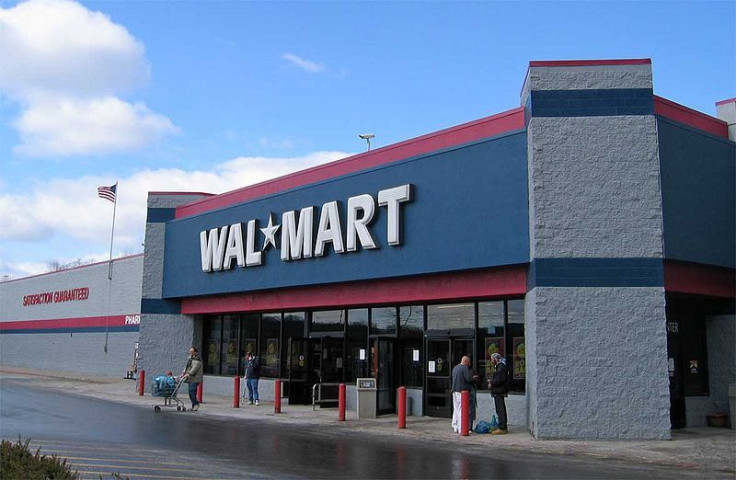Wal-Mart Stores (WMT) Earnings Preview: Q3 2014 Profit Seen Modestly Higher Despite Weak Retail Environment

Wal-Mart Stores, Inc. (NYSE:WMT) is expected to report a roughly 4 percent third-quarter earnings increase as cheaper gasoline encouraged customers to shop at the world's biggest retailer, especially at its Sam's Club outlets, and the company lowered costs by trimming inventory.
The Bentonville, Ark., company, which reports Thursday before the market opens, is expected to announce EPS for its fiscal 2014 third quarter, which ended Oct. 31, of $1.13 on revenue of $116.84 billion, according to an analyst poll by Thomson Reuters. That compares with EPS of $1.08 on revenue of $113.93 billion in the year-ago period. Net income is forecast to be $3.69 billion, up from $3.64 billion a year earlier.
Wal-Mart, which has missed earnings estimates the last two quarters and revenue estimates in six of the last seven quarters, is forecasting EPS in a range of $1.11 to $1.16.
By virtue of its size, Wal-Mart's performance is seen as a window into the economy. Analysts will scrutinize the company's results to see if better employment and cheaper gasoline offset low inflation, which hits the company's pricing power -- especially in food sales -- and thus profit margins, the impact of Obamacare and the nation's unusually weak economic recovery.
In the U.S., the government shutdown in early October hurt sales, said Paul Trussel, a Deutsche Bank analyst. "Weighed down in recent quarters by low grocery inflation and weak traffic trends, we believe the reatiler experienced little reprieve this period as the October government shutdown's negative impact on consumer confidence likely hurt sales," he wrote in a Nov. 8 note.
Cautious consumer spending because of the weak recovery and a change in spending patterns have weakened retail in the U.S., Wal-Mart’s largest market, thus slowing Wal-the company's top-line growth in the last several quarters.
"Consumers remain cautious on spending and the company is seeing the impact of government silliness in stores," David Strasser, Janney Capital Market analyst, said in an Oct. 16 note. "It is difficult to calculate the exact impact, but the company spoke of a tough top line across most markets."
Same-store sales are expected to increase, however, with a consensus view of 0.3 percent to 0.4 percent growth. UBS analyst Jason DeRise expects flat same-store sales, while Goldman Sachs expects a slightly-better-than-consensus number.
Over the last two quarters, Wal-Mart’s inventories have grown faster than sales, which has caused an inventory hangover, according to a recent Trefis note. In response, Wal-Mart cut orders from suppliers in September for the third and fourth quarters of fiscal 2014, adjusting to expected weak demand for some products. The company also has invested heavily in its supply chain and increased delivery speeds by 15 percent.
Sam’s Club, Wal-Mart's membership warehouse subsidiary, has been a strong performer for the company, said Patrick McKeever of MKM Partners. He expects Sam’s Club sales growth of 1 percent. Apparel, produce and health and family care have driven sales, he said. Goldman Sachs said it expects Sam's Club sales climbing 2 percent over the year-earlier quarter. DeRise of UBS sees "Sam's Club retail sales growth of 3.8 percent driven by a 2 percent comparable store sales estimate without fuel and 1.6 percent with fuel."
The company, which has 10,700 stores worldwide and whose international sales account for 29 percent of total sales, has also been taking a tough look at its overseas operations, closing underperforming stores in Brazil, Mexico, India and China, which will cut sales by about 2 percent but hike profitability, Strasser said, adding that Wal-Mart gained market share in all markets expect Japan and the U.K.
The retailer has been hit by high single- and double-digit wage increases in Brazil, China and Mexico that are causing operating expenses to grow faster than the rate of sales," Matt Nemer, senior analyst with Wells Fargo, wrote in an Oct. 16 note.
“We are encouraged that multi-channel initiatives are becoming a strategic priority and our analysis shows progress at Walmart.com, but our enthusiasm is tempered by… the distraction of lower return international investments,” Wells Fargo analysts wrote.
© Copyright IBTimes 2024. All rights reserved.












